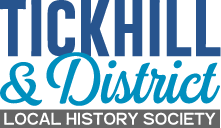

Agricultural Shows
People in agricultural areas have always taken great pride in their crops and livestock and, in turn, took great pleasure in displaying them at the local agricultural show. These ranged from the national Royal Show, which first came to nearby Doncaster in 1891 and returned at intervals until 1912, to smaller local village shows. Competitions for best breeds of livestock, crops, fruit, vegetables and flowers, tugs-of-war and displays of ploughing, together with fairground rides and sideshows were all part of the eagerly anticipated annual event.
Tickhill Show
With its many street farms, larger outlying farms and close proximity to the Sandbeck estate, Tickhill has always had a long association with agriculture. Tickhill Show was traditionally held on August Bank Holiday Monday: it was a gala day and a great bank holiday attraction. Since 1861 it had been organised by Tickhill Horticultural Society (which amalgamated with the Horse, Foal & Athletic Association in 1900); for many years in the late 19th and early 20th centuries, it was held in a field lent by Major Todd-Naylor of Sunderland House. A Show Committee, made up of local dignitaries, farmers and traders, was responsible for organising the event, which was always well supported by the local gentry of the neighbourhood, including the Earl and Countess of Scarbrough and Viscount and Viscountess Galway from nearby Serlby Hall, and attracted up to 3,000 visitors.
Horticultural exhibitors were divided into three classes: Professional Gardeners & Gentlemen, Amateurs and Cottagers, and within each class there were four groups: cut flowers, plants in pots, vegetables and fruit; in the early 20th century, around 1,000 exhibitors participated – all hopeful of a prize. Special prizes were always awarded: among the benefactors in 1900 were Miss Leather of The Friary, who gave three shillings and two shillings respectively for first and second prizes for the ‘best window box growing plants’, and the Doncaster Mutual Co-operative and Industrial Society, who awarded a copper kettle for the ‘best tray of vegetables’.
There were two main classes for horses: Agricultural and Hackney - each having groups for brood mare with foal, yearling, hunter, two-year old gelding, foal, colt and filly; other groups included tradesman’s turnout and, groomed carthorse and harness. Entries came not only from the local area but also from as far away as York, Nottinghamshire and Lincolnshire, and upwards of 150 horses were shown each year. In 1914 despite the outbreak of war, and subsequent acquisition of the railways for the transportation of troops and equipment, which had curtailed the number of non-local exhibitors, entries were still well above average. Local exhibitors faired well in the prizes: first and second prize in the ‘Best groomed carthorse and cart harness’ group went to Robert Chester of Galley Hill Farm and builders Rawson & Sons respectively, whilst Mark Law of Eastfield Farm won first and third prizes for the ‘Best dairy cow in milk’.
The sporting element of the show was just as popular with categories for men, boys under fourteen and boys under ten; there were no events however for women or girls – it would appear it was considered un-ladylike for them to compete. Events included flat races over different distances, hurdles and a bike race. In 1894, the first prize in the men’s events was 60/- (£3.00) with 20/- (£1.00) for the runner-up; the boys’ prizes were 10/- (50p) and 5/- (25p) respectively. Although there was an entrance fee of 1/- (5p) per event for men (children’s were free), one could speculate that these events attracted a large number of competitors, as the value of the first prize was more than a week’s wage at the time.
As well as the main events there were also ploughing and tug of war competitions, prizes for the best blocks of butter and best dozen eggs, stalls of fancy goods, cakes, jams and preserves and entertainment, usually provided by Tickhill Jubilee Brass Band. Admission to the Show was 6d (2½p) or 1/- (5p) in the show enclosure.